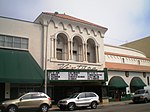Petunia Pickle Bottom
2000 establishments in CaliforniaAmerican companies established in 2000Clothing companies established in 2000Companies based in Ventura County, CaliforniaFashion accessory brands ... and 3 more
Luggage manufacturersManufacturing companies based in CaliforniaManufacturing company stubs

Petunia Pickle Bottom is an American manufacturer of diaper bags, handbags (branded only as "Petunia") and other women's accessories. The company was founded in 2000 in Ventura, California by DeNai and Braden Jones together with Korie Conant. Its products became fashionable in the U.S. after being featured on Oprah Winfrey's talk show.
Excerpt from the Wikipedia article Petunia Pickle Bottom (License: CC BY-SA 3.0, Authors, Images).Petunia Pickle Bottom
South Kalorama Street, Ventura
Geographical coordinates (GPS) Address Nearby Places Show on map
Geographical coordinates (GPS)
| Latitude | Longitude |
|---|---|
| N 34.276783 ° | E -119.287161 ° |
Address
South Kalorama Street 499
93001 Ventura
California, United States
Open on Google Maps











